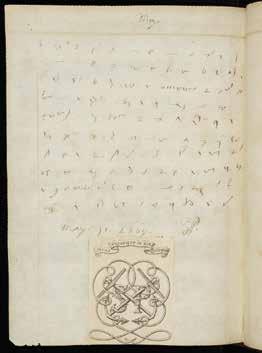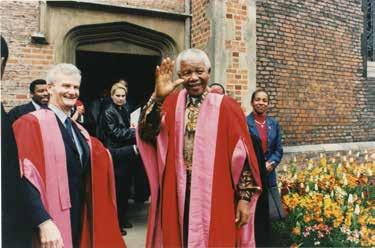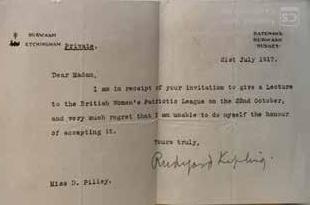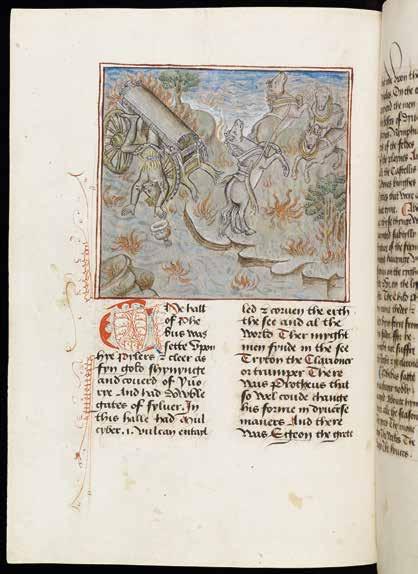
9 minute read
V Libraries
COLLEGE LIBRARY. As the College Library moves into the last year in its current location in the Pepys Building, we are pleased to report that our biennial library survey demonstrated increases both in the number of our students using the Library on a daily basis and in the numbers who consider the collection ‘good’ or ‘very good’. This is supported by another year of increased borrowing. Improving the collection across all subjects has been a core priority over the last two years, so this feedback is particularly satisfying for Library staff. We are always very grateful to our users for being so generous with their time and thoughts in filling in the survey; it has again proved a great source of encouragement, ideas and constructive criticism. We have also had a great response to our newly introduced feedback walls, which have given us the chance to respond quickly to issues and suggestions raised on a daily basis. Preparations for the move to the new library in 2020 have continued throughout this year. In anticipation of potential noise disruption (Left Cloister is a stone’s throw from the building site) we converted Ramsay Hall into a study room. The Ramsay Hall study room was very popular, providing not just additional desks with (Photo: Tom Sykes) plenty of power points, but also a different type of study space in the form of sofas, armchairs and beanbags.
In April, the Deputy Librarian (College) co-organised a workshop at the Oxford and Cambridge College Library Conference on the topic of building and refurbishing libraries, which was a good opportunity to share some of the experiences we have had so far, and to gather ideas as we continue planning for the new library.
Advertisement
Our project to improve the classification scheme has also continued this year, with the European History section being reclassified over the summer months. Preparations for a large scale reclassification of over 5,000 books spread across several sections planned for the summer of 2019 has also been ongoing all year. The College Library’s collection has been enriched by a number of donations from alumni and friends of the College. Tom Sykes
PEPYS LIBRARY AND HISTORIC COLLECTIONS. The year has been busy for the Historic Libraries and Archives – day-to-day work combining with preparations for making the most of the opportunities afforded by the new library.
Personnel: The College has appointed a new Archivist, Dr Tilda Watson, who joined us in October from Girton College where she was Assistant Archivist. With a PhD in Anglo-Saxon studies, Tilda has expertise in digital archives and catalogues as well as in conservation and archive management. Dr Hyam, Fellow Archivist from 2000, retired in October and was awarded the title Archivist Emeritus in recognition of his outstanding work in preserving, recording and researching the historic documents of the College over many years. He continues to advise us, and has been closely involved with recent exhibitions. We are also very happy to congratulate Ellie Swire, our Libraries Assistant, who successfully completed her postgraduate diploma in Library and Information Studies at UCL. The summer intern in 2018 was Charlotte Westdijk, who was completing her MA in Librarianship at the University of Sheffield. She worked on our Ferrar project, which seeks to make available to the wider community the current scholarship surrounding our remarkable collection of documents from the seventeenth and eighteenth centuries. The College has established two positions for student invigilators to assist in the Pepys Library at busy times.
Readers and Visitors: In the Pepys Library there were 89 readers’ visits in which a wide range of materials were examined, from medieval manuscripts to scientific books, music and devotional tracts. Visitors in public opening hours numbered 4914; the Pepys opened for the University Festival of Ideas, attracting no fewer than 617 visitors mostly across two busy weekends. The Pepys Librarian gave 35 tours and talks, welcoming an additional 660 visitors, and there were three school days when the Deputy Librarian spoke to school groups about the Great Fire of London. There were 21 special openings for the College (NRM nights, 'Friends' events, student evenings etc), with 290 visitors. In the Old Library, we have welcomed 32 visits by readers, and in the Archives, 57. In addition, 81 enquiries about the Archive Collections were received and answered. The total number of visits represents an 8% increase on last year. Sales of books, tours and fees amounted to just over £18,000.
Exhibitions: We started the year with an exhibition called ‘Materials of the Pepys Library’. This examined the materials of book production found in the collection including parchment, ink, glue, paper, string, leather and wood. The exhibition was in conjunction with a conference on paper in the Faculty of English. For the Festival of Ideas (which took the theme Extremes), the Pepys Library hosted an exhibition entitled: ‘Extreme Collecting’, displaying the largest and smallest books, the oldest and newest and so on.
The ‘Pepys and Women’ exhibition was mounted for the Friends of the Pepys Library and 'The end of the diary' exhibition to commemorate the final entry in Pepys’s diary.

PL 2040: The diary of Samuel Pepys, the entry for 31 May 1669
This is the final page of Pepys’s diary, which he kept from 1660–1669. This year is the 350th anniversary of the final diary entry. Pepys gave up his diary because he thought his eyesight was deteriorating, though his fears of blindness turned out to be unfounded. He resolved to keep some notes of his activities with the help of his colleagues, though this never materialised.
The final passage reads:
And thus ends all that I doubt I shall ever be able to do with my own eyes in the keeping of my journall, I being not able to do it any longer, having done now so long as to undo my eyes almost every time that I take a pen in my hand; and, therefore, whatever comes of it, I must forbear: and, therefore resolve from this time forward to have it kept by my people in long-hand, and must therefore be contented to set down no more than is fit for them and all the world to know; or, if there be any thing, which cannot be much, now my amours to Deb are past, and my eyes hindering me in almost all other pleasures, I must endeavour to keep a margin in my book open, to add here and there, a note in short-hand with my own hand. And so I betake myself to that course, which [is] almost as much as to see myself go into my grave - for which, and all the discomforts that will accompany my being blind, the good God prepare me!
The Archivist mounted a display ‘Mandela in Magdalene’ in December 2018, to mark what would have been Nelson Mandela’s 100th birthday. This was held in the Cripps Building alongside a special event in the auditorium.

Nelson Mandela with the President, Professor Cornish, after his admission in the College Chapel on 2 May 2001
An initiative which began in February 2019 to open the Old Library with a different small display on the first Thursday of each month has been a great success. Displays on ‘Student Life’, ‘Bookbindings’, ‘Manuscripts’, ‘Rudyard Kipling’ and ‘Fragments and Manuscript Waste’ attracted 274 visitors.

This letter from Kipling to Miss D Pilley (Mrs I A Richards) was found in one of the books in the I A Richards Collection. (Professor I A Richards; 1911, Honorary Fellow)

F.4.34: Ovid’s Metamorphoses parts I-IX by the Caxton Master [c 1483] f 39v, illustration of ‘Phaethon’s Fall’
The Metamorphoses manuscript was produced in around 1483, using Caxton’s translation of the text into English which was completed three years earlier, from a French version which added moral interpretations of the stories (known as the Ovide Moralisé). It serves as a useful reminder that Caxton, although famous for his printing exploits, was also a writer, translator and diplomat. The manuscript is written in a style of handwriting called ‘bâtarde bourguignonne’ or ‘lettre bâtarde’ commonly used in Flemish manuscript making.
Conservation: In our first full year as members of the Cambridge Conservation Consortium, we have been able to conserve several important volumes, including the Maitland Quarto. There has been a major project to clean the books in the Old Library with the assistance of a team of heritage volunteers from the Arts Society, who have examined each volume, prepared a condition report and dusted both the books and the shelves. Items from the Archives Collections have been rehoused into new, conservation-grade packaging and boxes in order to halt the deterioration of records, ensure their preservation for the future, and prepare the collections for the physical move to the new Archive Centre. This project will run up to 2020. Audio-visual materials have been digitised.
Cataloguing: In October, the most recent volume of the Catalogue of the Pepys Library was launched (reviewed below, p 90). A highlight of the year was the completion of the on-line shelf-list of the Old Library holdings, which is the work of the Deputy Librarian. This allows scholars and readers to find out what we have; and it also helps us maintain a searchable record of inscriptions, donors and marginal annotations. The College contributed to the 'Material Evidence in Incunabula' project, hosted by the Consortium of European Research Libraries. The Archivist has worked on converting the existing archive handlist, which is currently only available as a Word document, into an electronic catalogue that can be made available on-line. This project involves some retrospective cataloguing, as well as editing the existing catalogue to create metadata which can be uploaded into a new cataloguing platform. The creation of an on-line catalogue is being undertaken as part of the implementation of a new archive management system and cataloguing software hosted by Cambridge University Library.
Loans and acquisitions: The Old Library lent items to the ‘Tenacity' exhibition at the Jamestown Museum, Virginia. There have been several donations to the Archives, including recently a student diary dating to the Second World War.
Friends of the Pepys and Special Collections: There were six events for the Friends, including the Annual Lecture, ‘Pepys and Women’, given by Dr Kate Loveman. In April, the Friends were guests of the Mary Rose Trust in Portsmouth, where lunch was had overlooking Victory and a private tour of the Mary Rose exhibition was arranged. Dr Hughes and Dr C S Knighton gave talks. The final event of the year’s programme was a presentation on ‘Baroque Dance’, with expert Mary Collins, who explained the difference between a jig and a minuet, illuminated the role of dance in the court of Charles II and entertained us with the story of Pepys’s wife and the dancing master. Donations to the Back-a-Book scheme covered the cost of restoration of all the books identified for 2018–19. M E J H








